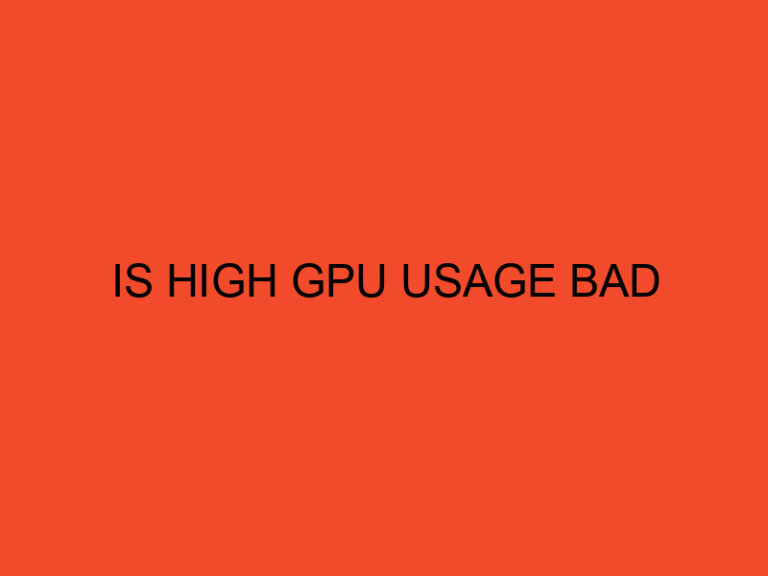In the world of technology, a central processing unit (CPU) is the brain of a computer. It handles all the calculations, processes data, and executes instructions. However, like any other electronic component, a CPU can sometimes fail or become “fried.” This article will guide you on how to identify if your CPU is fried and provide some troubleshooting steps to help you address the issue.
Table of Contents
What Is a Fried CPU?
A fried CPU refers to a central processing unit that has suffered permanent damage due to excessive heat, power surges, or manufacturing defects. When a CPU is fried, it means that it is no longer functioning properly, leading to system instability, crashes, or even a complete failure to boot.
Signs of a Fried CPU
Identifying whether a CPU is fried can be challenging, but there are certain signs that can indicate a problem:
- System Failure: If your computer fails to turn on or experiences frequent crashes and blue screens of death (BSOD), it could be an indication of a fried CPU.
- No Display: If your monitor remains blank even when the computer is powered on, it could be a result of a faulty CPU.
- Overheating: Excessive heat is a common cause of CPU damage. If your computer’s cooling system fails to keep the CPU temperature in check, it may result in a fried CPU.
- Burning Smell: A distinct burning smell coming from your computer can be a clear indication of a fried CPU. It suggests that the CPU has suffered significant damage due to overheating.
- Unresponsive System: If your computer becomes unresponsive, freezes frequently, or lags excessively, it could be due to a faulty CPU.
Troubleshooting a Fried CPU
If you suspect that your CPU is fried, you can perform the following troubleshooting steps:
- Check Power Connections: Ensure that all power connections to your computer are secure. Loose connections can sometimes cause issues that mimic a fried CPU.
- Inspect Cooling System: Check if the CPU cooling system, including the fan and heat sink, is functioning correctly. Clean any accumulated dust or debris that might obstruct proper airflow.
- Remove and Reinstall CPU: If you are comfortable doing so, carefully remove the CPU from the motherboard and inspect it for any visible signs of damage, such as bent pins or burn marks. Reinstall it securely if no visible damage is found.
- Test with Another CPU: If you have access to another compatible CPU, try swapping it with the suspected fried CPU to see if the problem persists. If the system functions normally with the replacement CPU, it confirms that the original CPU is indeed fried.
It’s important to note that troubleshooting a fried CPU can be complex and may require technical expertise. If you are uncertain or uncomfortable performing these steps, it is advisable to seek professional assistance.
Preventing CPU Damage
To prevent CPU damage and minimize the risk of frying your CPU, consider the following preventive measures:
- Proper Cooling: Ensure that your computer has adequate cooling, including proper airflow, well-functioning fans, and a clean heat sink. Regularly clean the inside of your computer to prevent dust buildup.
- Quality Power Supply: Invest in a high-quality power supply unit (PSU) that provides stable power to your computer. Avoid using cheap or unbranded PSUs, as they can be unreliable and prone to power surges.
- Surge Protector: Use a surge protector or an uninterruptible power supply (UPS) to protect your computer from sudden power fluctuations or electrical surges.
- Avoid Overclocking: Overclocking your CPU can increase its performance but also raises the risk of overheating and damage. If you are not familiar with overclocking, it’s best to avoid it.
- Regular Maintenance: Perform regular maintenance on your computer, such as updating drivers, running antivirus scans, and keeping your operating system up to date. This helps maintain system stability and reduces the chances of CPU damage.
Conclusion
A fried CPU can be a frustrating experience, causing your computer to malfunction or fail entirely. By familiarizing yourself with the signs of a fried CPU and following the troubleshooting steps outlined in this article, you can determine whether your CPU is the culprit and take appropriate action. Remember to take preventive measures to minimize the risk of CPU damage and maintain the longevity of your computer.
FAQs
Can a fried CPU be repaired?
No, a fried CPU cannot be repaired. Once a CPU suffers permanent damage, the only solution is to replace it with a new one.
How long does a CPU typically last?
A CPU’s lifespan can vary depending on usage, quality, and maintenance. On average, a CPU can last anywhere from 5 to 10 years or more.
Can a faulty power supply damage a CPU?
Yes, a faulty or low-quality power supply can cause power surges or inconsistent power delivery, which can damage the CPU and other components.
Is it safe to touch a CPU?
It is generally safe to touch the top of a CPU, but you should avoid touching the pins on the underside as they are delicate and can be easily damaged.
Can a CPU overheat if the fan is working?
Yes, a CPU can overheat even if the fan is working if there are other factors at play, such as a clogged heat sink, improper airflow, or an inadequate cooling system.






